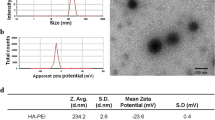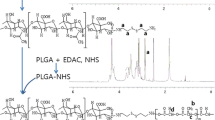Abstract
Background
Gastric cancer (GC) is the second most common leading cause of cancer-related death. Cancer stem cell (CSC) with the mark of CD44 played an important role in GC. rMETase was wildly exploited as chemotherapeutic option for GC. Polymers synthetic nanoparticle drug delivery systems have been commonly used for cancer therapy. With the decorating of Hyaluronic acid (HA), a receptor of CD44, nanoparticles exhibit with good biocompatibility and aqueous solubility.
Methods
The characteristic of nanoparticles (NPs) was analyzed by TEM and DLS. The viability and proliferation of GC cells were examined by MTT assays. The levels of CD44, Cyt C, and c-caspase 3 were examined by Western blot. The level of ROS was measured by DCFH-DA assays. The morphology of tissues was detected using hematoxylin–eosin (H&E) stain. Nude mice xenograft models were used to evaluate the effect of HA-PAMAM-Au-METase on GC.
Results
The transfection of rMETase carried by HA-G5 PAMAM-Au visibly inhibited the proliferation and tumorsphere formation of GC cells through obviously enhancing METase activity. Elevation of METase activity suppressed the proliferation of CD44(+) GC cells through down-regulating MET in cellular supernatant that resulted in the increase of Cyc C and ROS levels. The number of CD44(+) GC cells in nude mice injected with G5 PAMAM-Au-METase decorated by HA was markly declined resulting in the inhibition of tumor growth.
Conclusion
HA-G5 PAMAM-Au-METase significantly suppressed tumor growth of GC by targeted damaging the mitochondrial function of CD44(+) gastric CSCs.





Similar content being viewed by others
References
Alison MR, Lin WR, Lim SML, Nicholson LJ (2012) Cancer stem cells: in the line of fire. Cancer Treat Rev 38:589–598
Baker JR Jr (2009) Dendrimer-based nanoparticles for cancer therapy, Hematol Am Soc Hematol Educ Program, 708–719
Bölke E, Peiper M, Budach W (2008) Capecitabine and oxaliplatin for advanced esophagogastric cancer. N Engl J Med 358:36–46
Chen J, Cao X, Guo R, Shen M, Peng C, Xiao T, Shi X (2012) A highly effective polymerase chain reaction enhancer based on dendrimer-entrapped gold nanoparticles. Analyst 137:223
de Andrade NP, Rodrigues MF, Rodini CO, Nunes FD (2016) Cancer stem cell, cytokeratins and epithelial to mesenchymal transition markers expression in oral squamous cell carcinoma derived from ortothopic xenoimplantation of CD44(high) cells, Pathology Research & Practice, 213:235–244
Deng J, Li N, Mai K, Yang C, Yan L, Zhang LM (2011) Star-shaped polymers consisting of a β-cyclodextrin core and poly(amidoamine) dendron arms: binding and release studies with methotrexate and siRNA. J Mater Chem 21:5273–5281
Flavio C (2016) Martina, Fiocch, Angelina, Sacchi, Alessandro, Gori, Anna, Gasparri, NGR-tagged nano-gold: a new CD13-selective carrier for cytokine delivery to tumors. Nano Res 9:1393
Han M, Lv Q, Tang XJ, Hu YL, Xu DH, Li FZ, Liang WQ, Gao JQ (2012) Overcoming drug resistance of MCF-7/ADR cells by altering intracellular distribution of doxorubicin via MVP knockdown with a novel siRNA polyamidoamine-hyaluronic acid complex. J Controlled Release 163:136–144
Harris CC (1996) Structure and function of the p53 tumor suppressor gene: clues for rational cancer therapeutic strategies. JNCI J Natl Cancer Inst 88:1442–1455
Hyung W, Ko H, Park J, Lim E, Park SB, Park YJ, Yoon HG, Suh JS, Haam S, Huh YM (2008) Novel hyaluronic acid (HA) coated drug carriers (HCDCs) for human breast cancer treatment. Biotechnol Bioeng 99:442
Ishimoto T, Nagano O, Yae T, Tamada M, Motohara T, Oshima H, Oshima M, Ikeda T, Asaba R, Yagi H (2011) CD44 variant regulates redox status in cancer cells by stabilizing the xCT subunit of system xc(−) and thereby promotes tumor growth. Cancer Cell 19:387–400
Jemal A, Bray F, Center MM, Ferlay J, Ward E, Forman D (2011) Global cancer statistics. Ca A Cancer J Clin 61:69
Kojima C, Regino C, Umeda Y, Kobayashi H, Kono K (2010) Influence of dendrimer generation and polyethylene glycol length on the biodistribution of PEGylated dendrimers. Int J Pharm 383:293–296
Kokkinakis DM, Brickner AG, Kirkwood JM, Liu X, Goldwasser JE, Kastrama A, Sander C, Bocangel D, Chada S (2006) Mitotic arrest, apoptosis, and sensitization to chemotherapy of melanomas by methionine deprivation stress. Mol Cancer Res 4:575–589
Kuo WY, Hwu L, Wu CY, Lee JS, Chang CW, Liu RS (2017) STAT3/NF-κB-Regulated Lentiviral TK/GCV Suicide Gene Therapy for Cisplatin-Resistant Triple-Negative Breast Cancer
Lee JH, Kim KM, Cheong JH, Noh SH (2012) Current management and future strategies of gastric cancer. Yonsei Med J 53:248–257
Li Volsi A, Jimenez de Aberasturi D, Henriksen-Lacey M, Giammona G, Licciardi M, Liz-Marzan LM (2016) Inulin coated plasmonic gold nanoparticles as a tumor-selective tool for cancer therapy. J Mater Chem B Mater Biol Med 4:1150–1155
Liang X, Li X, Chang J, Duan Y, Li Z (2013) Properties and evaluation of quaternized chitosan/lipid cation polymeric liposomes for cancer-targeted gene delivery. Langmuir 29:8683–8693
Ma N, Wu FG, Zhang X, Jiang YW, Jia HR, Wang HY, Li YH, Liu P, Gu N, Chen Z, Shape-dependent radiosensitization effect of gold nanostructures in cancer radiotherapy: comparison of gold nanoparticles, Nanospikes
Machover D, Zittoun J, Saffroy R, Broët P, Giraudier S, Magnaldo T, Goldschmidt E, Debuire B, Orrico M, Tan Y (2002) Treatment of cancer cells with methioninase produces DNA hypomethylation and increases DNA synthesis. Can Res 62:4685–4689
Miki K, Alrefaie W, Xu M, Jiang P, Tan Y, Bouvet M, Zhao M, Gupta A, Chishima T, Shimada H (2000a) Methioninase gene therapy of human cancer cells is synergistic with recombinant methioninase treatment. Can Res 60:2696–2702
Miki K, Xu M, An Z, Wang X, Yang M, Al-Refaie W, Sun X, Baranov E, Tan Y, Chishima T (2000b) Survival efficacy of the combination of the methioninase gene and methioninase in a lung cancer orthotopic model. Cancer Gene Ther 7:332–338
Naor D (2016) Editorial: interaction between hyaluronic acid and its receptors (CD44, RHAMM) regulates the activity of inflammation and cancer. Front Immunol 7:39
Oh EJ, Park K, Kim KS, Kim J, Yang JA, Kong JH, Lee MY, Hoffman AS, Hahn SK (2010) Target specific and long-acting delivery of protein, peptide, and nucleotide therapeutics using hyaluronic acid derivatives. J Controlled Rel Off J Control Rel Soc 141:2–12
Pissuwan D, Niidome T, Cortie MB (2011) The forthcoming applications of gold nanoparticles in drug and gene delivery systems. J Control Release 149:65–71
Platt VM, Jr SF (2008) Anticancer therapeutics: targeting macromolecules and nanocarriers to hyaluronan or CD44, a hyaluronan receptor. Mol Pharm 5:474–486
Rocco A, Compare D, Nardone G (2012) Cancer stem cell hypothesis and gastric carcinogenesis: experimental evidence and unsolved questions. World J Gastrointestinal Oncol 4:54–59
Shah MA, Kelsen DP (2010) Gastric cancer: a primer on the epidemiology and biology of the disease and an overview of the medical management of advanced disease. J Natl Comprehensive Cancer Netw JNCCN 8:437–447
Shan Y, Luo T, Peng C, Sheng R, Cao A, Cao X, Shen M, Guo R, Tomás H, Shi X (2012a) Gene delivery using dendrimer-entrapped gold nanoparticles as nonviral vectors. Biomaterials 33:3025–3035
Shan Y, Luo T, Peng C, Sheng R, Cao A, Cao X, Shen M, Guo R, Tomas H, Shi X (2012b) Gene delivery using dendrimer-entrapped gold nanoparticles as nonviral vectors. Biomaterials 33:3025–3035
Takaishi S, Okumura T, Tu S, Wang SSW, Shibata W, Vigneshwaran R, Gordon SAK, Shimada Y, § TCW (2009) Identification of gastric cancer stem cells using the cell surface marker CD44 † ‡. Stem Cells 27:1006–1020
Tan Y, Sun X, Xu M, Tan X, Sasson A, Rashidi B, Han Q, Tan X, Wang X, An Z (1999) Efficacy of recombinant methioninase in combination with cisplatin on human colon tumors in nude mice. Clin Cancer Res 5:2157–2163
Uthaman S, Zheng S, Han J, Choi YJ, Cho S, Nguyen VD, Park JO, Park SH, Min JJ, Park S (2015) Preparation of engineered salmonella typhimurium-driven hyaluronic-acid-based microbeads with both chemotactic and biological targeting towards breast cancer cells for enhanced anticancer therapy. Adv Healthcare Mater 5:288–295
Vile RG, Nelson JA, Castleden S, Chong H, Hart IR (1994) Systemic gene therapy of murine melanoma using tissue specific expression of the HSVtk gene involves an immune component. Can Res 54:6228
Wu X, Ding B, Gao J, Wang H, Fan W, Wang X, Zhang W, Wang X, Ye L, Zhang M (2011) Second-generation aptamer-conjugated PSMA-targeted delivery system for prostate cancer therapy. Int J Nanomed 6:1747
Xu W, Chen Q, Wang Q, Sun Y, Wang S, Li A, Xu S, Røe OD, Wang M, Zhang R (2014) JWA reverses cisplatin resistance via the CK2—XRCC1 pathway in human gastric cancer cells. Cell Death Dis 5:e1551
Yang Z, Wang J, Lu Q, Xu J, Kobayashi Y, Takakura T, Takimoto A, Yoshioka T, Lian C, Chen C (2004) PEGylation confers greatly extended half-life and attenuated immunogenicity to recombinant methioninase in primates. Can Res 64:6673–6678
Yoon C, Park DJ, Schmidt B, Thomas NJ, Lee HJ, Kim TS, Janjigian YY, Cohen DJ, Yoon SS (2014) CD44 expression denotes a subpopulation of gastric cancer cells in which Hedgehog signaling promotes chemotherapy resistance. Clin Cancer Res 20:3974
Yu H, Nie Y, Dohmen C, Li Y, Wagner E (2011) Epidermal growth factor-PEG functionalized PAMAM-pentaethylenehexamine dendron for targeted gene delivery produced by click chemistry. Biomacromol 12:2039–2047
Yu M, Jambhrunkar S, Thorn P, Chen J, Gu W, Yu C (2013) Hyaluronic acid modified mesoporous silica nanoparticles for targeted drug delivery to CD44-overexpressing cancer cells. Nanoscale 5:178–183
Acknowledgements
This work was supported by The National Natural Science Foundation of China (Nos. 81560492 and 81760549).
Author information
Authors and Affiliations
Corresponding author
Ethics declarations
Conflict of interest
All authors declare that there is no conflict of interest.
Research involving human participants and/or animals
Yes, animals were involved in the present study.
Ethical approval
The study was approved by ethics committee of hospital.
Informed consent
The study was undertaken with the hospital’s consent.
Electronic supplementary material
Below is the link to the electronic supplementary material.
Rights and permissions
About this article
Cite this article
Li, YF., Zhang, HT. & Xin, L. Hyaluronic acid-modified polyamidoamine dendrimer G5-entrapped gold nanoparticles delivering METase gene inhibits gastric tumor growth via targeting CD44+ gastric cancer cells. J Cancer Res Clin Oncol 144, 1463–1473 (2018). https://doi.org/10.1007/s00432-018-2678-5
Received:
Accepted:
Published:
Issue Date:
DOI: https://doi.org/10.1007/s00432-018-2678-5




